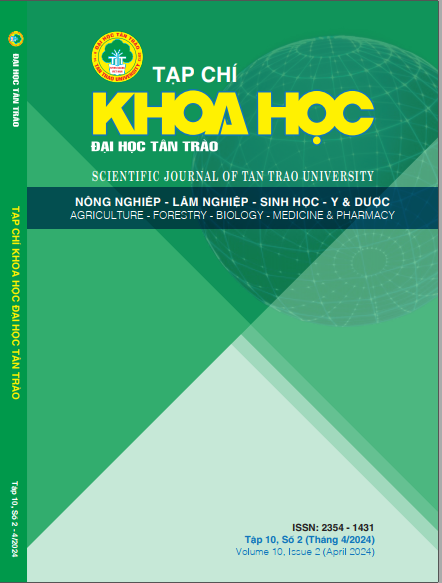BUILDING A PROCESS FOR ISOLATION AND SPAWN PRODUCTION OF STORK’S NECK REISHI MUSHROOM FROM PHU QUOC
DOI:
https://doi.org/10.51453/2354-1431/2024/1082Abstract
Stork's neck reishi mushroom is a type of medicine mushroom in Vietnam which limited in research. A few articles showed that this type of reishi mushroom has positive effects on cancer cell lines, diabetes, anti-inflammation and antioxidants tests. In this research, sample of stork's neck reishi mushroom collected from Phu Quoc National Park, Kien Giang province, Vietnam are isolated and prepared for production trial of spawn. The result indicated that the mycelium grow well on PGA medium, and covered the surface of the culture plate after 10 days of culture. Sequencing of the 18S gene showed that the fungal sample was related to the species Ganoderma neojaponicum. The isolation process should be carried out when the mushroom fruit body is young, white, and soft. Mushroom culture temperature ranges from 20-28 oC. The spawn grow well on rice substrate supplemented with CaCO3 1,5%, KH2PO4 0,5 g/l, K2HPO4 (g/l), MgSO4.7H2O 0,5 g/l. Mycelium inoculation should be conducted at the middle of substrate bags, time to cover substrate is around 18-20 days.
Downloads
References
Alaa O. Aboraya, Yousif Elhassaneen, Olfat M. Nassar (2022) Reishi Mushroom (Ganoderma lucidum) Intervention Improves Lipids Profile and Paraoxonase/Arylesterase Activities in Serum as well as Enhances Haemostatic Effects in Streptozotocin-Induced Diabetic Rats, Alexandria Science Exchange Journal 43(4):593-608.
Bich Thuy Thi Nguyen, Nghien Xuan Ngo , Ve Van Le , Luyen Thi Nguyen , Ry Kana , Huy Duc Nguyen (2019) Optimal culture conditions for mycelial growth and fruiting body formation of Ling Zhi mushroom Ganoderma lucidum strain GA3, Life Sciences | Biotechnology; Doi: 10.31276/VJSTE.61(1).62-67 DOI:10.21608/asejaiqjsae.2022.271965 Mai Gharib, Yousif Elhassaneen, Hanan Radwan (2022) Nutrients and Nutraceuticals Content and Technology - Thai Nguyen University, page 180, No. 04.
Vikineswary Sabaratnam (2020) In vitro and in silico anticancer evaluation of a medicinal mushroom, Ganoderma neo‐japonicum Imazeki, against human colonic carcinoma cells, Biotechnology and Applied Biochemistry;
https://www.academia.edu/110186165/ I n _ v i t r o _ a n d _ i n _ s i l i c o _ a n t i c a n c e r _ evaluation_of_a_medicinal_mushroom_ Ganoderma_neo_japonicum_Imazeki_against_human_colonic_carcinoma_cells
Wee-Cheat Tan, Umah Rani Kuppusamy, Chia- Wei Phan, Yee-Shin Tan, Jegadeesh Raman, Azliza Mad Anuar, Vikineswary Sabaratnam
(2015) Ganoderma neo-japonicum Imazeki revisited: Domestication study and antioxidant properties of its basidiocarps and mycelia, SCIENTIFIC RepoRts | 5:12515 | DOI: 10.1038/srep12515 Xuanwei Zhou, Kai-Qi Su, Yong-Ming Zhang (2011) Applied modern biotechnology for cultivation of Ganoderma and development of their products, Applied Microbiology and Biotechnology, 93(3):941-63 DOI:10.1007/ s00253-011-3780-7.
and In Vitro Biological Activities of Reishi Mushroom (Ganoderma lucidum) Fruiting Bodie, Alexandria Science Exchange Journal 43(2):301-316, DOI:10.21608/ asejaiqjsae.2022.245271Authors: Nguyen Lan Dung (2003). Mushroom Cultivation Technology, Volume 1. Agricultural Publishing House.
Rui-rui Zhang, Jing Zhang, Xu Guo, Ying-ying Chen, Jin-yue Sun, Jia-lin Miao, M. Carpena, M.A. Prieto, Ning-yang Li, Qing-xin Zhou, Chao Liu (2023) Molecular mechanisms of the chemical constituents from anti-inflammatory and antioxidant active fractions of Ganoderma neo-japonicum Imazeki, Current Research in Food Science, Volume 6, 2023, 100441;
https://doi.org/10.1016/j.crfs.2023.100441
Sarasvathy Subramaniam, Vikineswary Sabaratnam, Chua Kek Heng, Umah Rani Kuppusamy (2020) The Medicinal Mushroom Ganoderma neo−japonicum (Agaricomycetes) from Malaysia: Nutritional Composition and Potentiation of Insulin-Like Activity in 3T3-L1 Cells, Int J Med Mushrooms, Volume 22, Issue 1, pp. 65-78; DOI: 10.1615/ IntJMedMushrooms.2020033250 Vi Dai Lam, Nguyen Xuan Vu, Dinh Van Thien, Vu Dinh Hoi, Bui Thanh Ngoc (2018). Isolation and Experimental Production of Leopard Skin Mushroom Strain at Thai Nguyen University of Agriculture and Forestry. Journal of Science
Downloads
Published
How to Cite
Issue
Section
License

This work is licensed under a Creative Commons Attribution-ShareAlike 4.0 International License.
All articles published in SJTTU are licensed under a Creative Commons Attribution-ShareAlike 4.0 International (CC BY-SA) license. This means anyone is free to copy, transform, or redistribute articles for any lawful purpose in any medium, provided they give appropriate attribution to the original author(s) and SJTTU, link to the license, indicate if changes were made, and redistribute any derivative work under the same license.
Copyright on articles is retained by the respective author(s), without restrictions. A non-exclusive license is granted to SJTTU to publish the article and identify itself as its original publisher, along with the commercial right to include the article in a hardcopy issue for sale to libraries and individuals.
Although the conditions of the CC BY-SA license don't apply to authors (as the copyright holder of your article, you have no restrictions on your rights), by submitting to SJTTU, authors recognize the rights of readers, and must grant any third party the right to use their article to the extent provided by the license.


